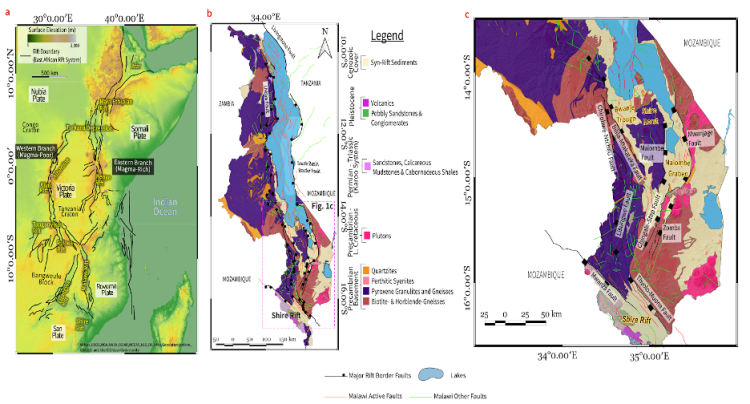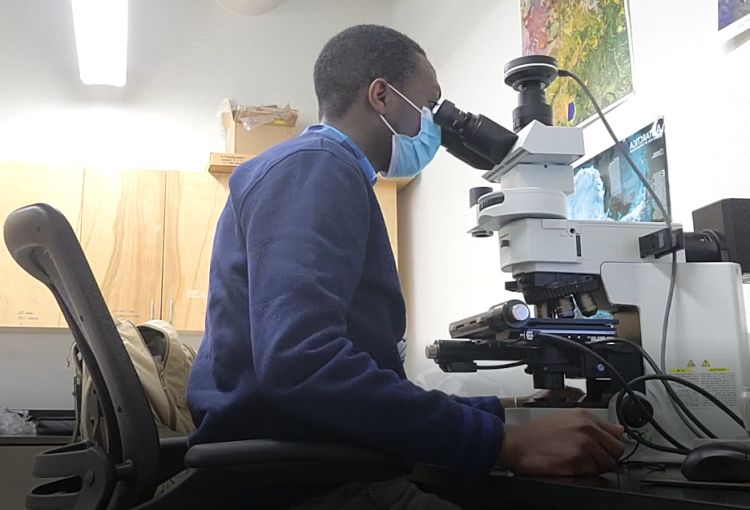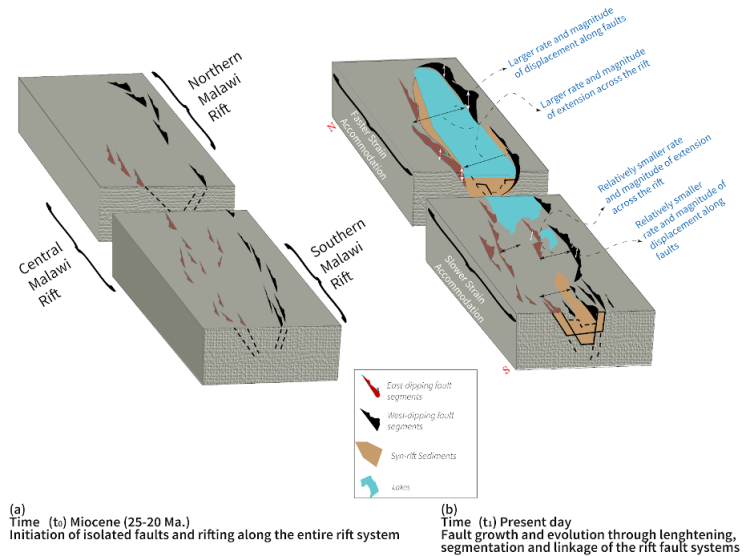Oyewande Ojo - Project Profile
2021 AGeS awardee
Lab: University of Arizona Fission-Track Laboratory, Tucson, Arizona
Lab Mentor(s): Stuart Thomson
What scientific question(s) does your research address and what motivates this work?
We investigate the longstanding question of how strain is accommodated and transferred along rifts over time by using the Malawi Rift as a case study. The results of the study provide an important basis for the comparison of strain accommodation along the Malawi Rift and the Shire Rift. This study aims to answer the following questions: 1) when did Cenozoic rifting begin in the southern Malawi Rift? and 2) Is there Cenozoic reactivated rifting in the older Carboniferous-Jurassic Shire Rift? Furthermore, we aim to test: 1) whether the initiation of rifting in the southern Malawi Rift is younger than in the northern Malawi Rift (Castaing et al., 1991; Daszinnies et al., 2008), and 2) if the geometry of the Southern Malawi Rift and Shire Rift at the transfer zone indicates strain is being accommodated by rift linkage of faults to support Cenozoic rifting and reactivation of the Shire Rift. Although low-temperature thermochronological studies have been conducted previously in the Malawi Rift (Eby et al., 1995; Van der Beek et al., 1998; Mortimer et al., 2016), there remains a data gap to constrain ages of onset of strain accommodation and transfer along the faults of the southern Malawi Rift and Shire Rift. Moreover, there is a lack of imaging of upper crustal structures in the transfer zone of these two rifts (Fig. 1). Thus, we do not know how strain is being accommodated nor the linkage between these two rift basins with different tectonic histories and orientations.

Figure 1: (a) Structural map of the East African Rift Systems shown on an elevation map. The black lines highlight the major rift bounding faults along each rift system. (b) Geologic and structural map of the Malawi Rift and Shire Rift highlighting the major border faults. (Modified from Bloomfield et al., 1965) (c) Geologic map of the study area, which includes the southern Malawi Rift and Shire Rift, showing the different geologic units and the major fault systems. The black text highlighted in yellow gives information about the rift, grabens, horst, or trough that host the different fault networks along/across the rift (Ojo et al., 2022).
What chronometric tool did you employ and why?
To achieve the objectives, we used apatite fission tracks and (U-Th)/He low-temperature thermochronology data from the footwall of several border faults. All samples were taken from igneous and high-grade metamorphic basement rocks of the Neoproterozoic Malawi Basement Complex (Tsunogae et al., 2021) and collected from lower elevations of the footwall within ~100 m of the fault to ensure they record the maximum amount of any cooling related to footwall exhumation. Fission tracks in apatite of average chemical composition begin annealing at ~60 °C, and fully fade at ~125 °C, the so-called partial annealing zone (PAZ) for an isothermal hold time of ~10-40 Ma (e.g. Gleadow and Duddy, 1981; Fitzgerald & Malusà, 2019) and thus record the thermal history of samples subject to tectonic exhumation processes of brittle deformation in the upper continental crust (~3–5 km) (Fig. 2). However, as the AFT annealing rate is temperature dependent, the temperature of the AFT PAZ decreases with longer heating times. We also selected two samples with abundant good quality apatite for AHe dating, acquiring 5 single grain age analyses on each sample. AHe dating generally has a slightly lower temperature sensitivity than AFT.

Figure 2: Lab visit at the fission-track laboratory, University of Arizona for AFT dating (January, 2021). Oyewande counting spontaneous and corresponding induced fission tracks in the mounted apatite grain samples.
What were some of the key takeaways of your research?
- Cooling ages and thermal episodes constrained by apatite fission-track and (U-Th)/He analysis suggest the onset of Cenozoic rifting is coeval along the full length of Malawi Rift.
- Miocene-Pliocene onset of rifting along the Southern Malawi Rift and linkage to reactivation of the older Shire Rift to its south.
- Lower extension magnitudes and rates southward along the Malawi Rift and high fault density suggests linkage between the Malawi Rift and the reactivated Shire Rift.

Figure 3: Conceptual model showing the evolution of the Malawi Rift in terms of strain accommodation from initiation. (a) Coeval initiation of isolated faults across the rift segments. Some of the faults overlap by soft linkages. (b) Present-day architecture of the rift. It shows the isolated faults have coalesced by hard linkage in the north at a rate greater than the magnitude of strain accommodation in the south which has isolated faults that have grown and linked by hard linkage and more soft linkages at a slower rate compared to the northern Malawi Rift (Ojo et al., 2022).
What new experiences, opportunities, and collaborations did you gain as an AGeS-Grad awardee?
This award provided me with quite a number of new experiences and opportunities. I have been part of teams in the past but for the first time, I got to spearhead a research project. I was in charge of developing the project from the onset and had to research various potential collaborators. I can personally say that this hands-on experience, was really vital to my development as a young geoscientist and how I see myself doing research going forward.
Apart from experiences and collaborations developed from my own project, the AGeS-Grad program’s various initiatives encouraged community among all the awardees. The learning experience for me did not stop with the successful completion of my research, I learnt a lot from what other awardees went through in their quest to finish their various research. I cannot overstate how important the AGeS-Grad Award has been to my career in terms of networking and future collaborations.
What is one piece of advice you have for future AGeS-Grad award applicants or awardees?
Make sure you have a well-thought-out scientific question(s)/problem(s) that you intend to address, this will help you immensely in your decision-making for the grant application and the project in general. It is never too early to start reaching out to potential collaborators and getting started with your proposal writing processes.
References:
Bloomfield, K. (1965). The geology of the Middle Shire Hydro‐Electric Power Sites in Records of the Geological Survey of Malawi VII, 29–44. Government Printer, Zomba, Malawi.
Castaing, C. (1991). Post-Pan-African tectonic evolution of South Malawi in relation to the Karroo and recent East African rift systems. Tectonophysics, 191(1–2), 55–73. https://doi.org/10.1016/0040-1951(91)90232-H
Daszinnies, Matthias & Emmel, Benjamin & Jacobs, Joachim & Grantham, Geoff & Thomas, Bob. (2008). Denudation In Southern Malawi and Northern Mozambique: Indications of the Long-term Tectonic Segmentation of East Africa During the Gondwana Break-up.
Eby, G. N., Roden-Tice, M., Krueger, H. L., Ewing, W., Faxon, E. H., & Woolley, A. R. (1995). Geochronology and cooling history of the northern part of the Chilwa Alkaline Province, Malawi. Journal of African Earth Sciences, 20(3–4), 275–288. https://doi.org/10.1016/0899-5362(95)00054-W.
Fitzgerald, P.G., & Malusà, M.G. (2019).. Concept of the exhumed partial annealing (retention) zone and age-elevation profiles in thermochronology. In: M. G. Malusà and P. G. Fitzgerald (eds.), Fission-Track Thermochronology and its Application to Geology, Springer Textbooks in Earth Sciences, Geography and Environment, pp.165–189, https://doi.org/10.1007/978-3-319-89421-8_9
Gleadow, A.J.W., & Duddy, I.R. (1981). A natural long-term track annealing experiment for apatite: Nuclear Tracks, v. 5, p. 169–174, doi:10.1016/0191-278X(81)90039-1.
Mortimer, E., Kirstein, L. A., Stuart, F. M., & Strecker, M. R. (2016). Spatio-temporal trends in normal-fault segmentation recorded by low-temperature thermochronology: Livingstone fault scarp, Malawi Rift, East African Rift System. Earth and Planetary Science Letters, 455, p. 62–72. https://doi.org/10.1016/j.epsl.2016.08.040
Ojo, O. O., Thomson, S., & Laó-Dávila, D. A. (2022). Neogene-Quaternary Initiation of the Southern Malawi Rift linked to Reactivation of the Carboniferous-Jurassic Shire Rift. Authorea Preprints. DOI: 10.1002/essoar.10511357.1
Tsunogae, T., Uthup, S., Nyirongo, M.W., Takahashi, K., Rahman, Md.S., Liu, Q., Takamura, Y., & Tsutsumi, Y. (2021). Neoproterozoic crustal growth in southern Malawi: New insights from petrology, geochemistry, and U–Pb zircon geochronology, and implications for the Kalahari Craton–Congo Craton amalgamation: Precambrian Research, v. 352, p. 106007, doi:10.1016/j.precamres.2020.106007.
Van der Beek, P., Mbede, E., Andriessen, P., & Delvaux, D. (1998). Denudation history of the Malawi and Rukwa Rift flanks (East African Rift system) from apatite fission track thermochronology. Journal of African Earth Sciences, 26(3), 363–385. https://doi.org/10.1016/S0899-5362(98)00021-9

